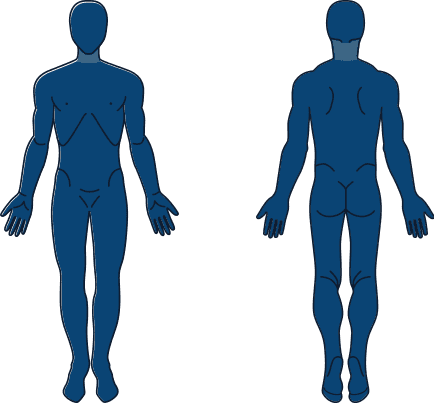What is a disk herniation?
- The disks of the spinal column are the circular cushions between the bony vertebrae. These disks are composed of a fibrous outer band and a pulp like center.
- A disk herniation occurs when the pulp like center is squeezed out through a weak point of the fibrous outer layer.
What are some of the typical causes of a disk herniation?
- A disk herniation may be caused by accidents, falls, any sudden jerking or strenuous movement, contact sports, or they may be spontaneous.
What are the symptoms of a disk herniation?
- Pain in the back or neck in the area of the herniation. Muscle spasms in the back or neck. Numbness, tingling, weakness, shooting pains in the body parts supplied by the nerves that originate in the area of the herniation.
What are some initial treatments?
- Rest, ice, anti-inflammatories, stretching, physical therapy, manual therapies, massage, and traction are some initial therapies to consider.
What is low back pain?
- Low back pain is one of the most common conditions that cause individuals to seek medical care.
- It is typified by pain and stiffness in the low back.
What are some of the typical causes of low back pain?
- There are many potential causes of low back pain, however the most common are strains of the muscles in the low back or sprains of the ligaments in the low back.
- Strains and sprains of the muscles of the low can be the result of accidents, sudden movements, lifting heavy objects, sports injuries, prolonged poor posture, or sometimes no cause is easily identified.
What are the symptoms of low back pain?
- Pain and stiffness in the low back, at times pain radiating up the back or down into the buttocks, leg stiffness.
What are some initial treatments?
- Ice, anti-inflammatories, heat (after the initial injury period), massage, stretching, physical therapy, manual therapies may all be helpful initial steps.
What is sacroiliac (SI) joint pain/dysfunction?
- The sacroiliac joint is the joint in the low back where the sacrum and ilium bones of the pelvis meet.
- SI joint dysfunction is a term describing pain in the SI region as a result of abnormal motion of the joint. This can be because of increased motion or not enough motion of the joint.
What are some of the typical causes of sacroiliac (SI) joint pain/dysfunction?
- Twisting, falling, heavy lifting, direct blows, hypermobile joints, tight hamstrings, muscle imbalances can all cause SI joint dysfunction.
What are the symptoms of sacroiliac (SI) joint pain/dysfunction?
- Low back pain, buttock pain, hip pain, groin pain, all varying in severity based on body position
What are some initial treatments?
- Ice after initial injury, stretching, anti-inflammatories, massage, manual therapy, and heat are all reasonable approaches.
What are spondylolysis and spondylolisthesis?
- Spondylolysis is a stress fracture of the pars interarticularis of the lumbar and sometimes cervical spine.
- The pars interarticularis is a bony structure that helps form the ring around the spinal cord.
- Spondylolisthesis is the slippage of one vertebrae compared to another.
What are some of the typical causes of spondylolysis and spondylolisthesis?
- The exact cause of spondylolysis is unknown, however it is more common with activities that require repetitive rotation and hyperextension of the spine.
- There are several causes of spondylolisthesis:
- Dysplastic spondylolisthesis results from congenital abnormalities (birth defects)
- Isthmic spondylolisthesis results from spondylolysis or a congenitally long pars
- Degenerative spondylolisthesis results from facet and joint arthritis of the spine
- Traumatic spondylolisthesis
- Pathologic spondylolisthesis is caused by infections or cancer
- Iatrogenic spondylolisthesis is a potential complication from back surgery
What are the symptoms of spondylolysis and spondylolisthesis?
- Back pain, stiffness, hamstring tightness, sometimes no symptoms.
What are some initial treatments?
- Anti-inflammatories, physical therapy, severe spondylolisthesis may require surgery.
What is upper back pain?
- Upper back pain is pain in the thoracic spine where the ribs attach between he neck and low back.
What are some of the typical causes of upper back pain?
- Upper back pain can be caused by sprains of the small ligaments in the back, strains of the muscles in the back, and injuries to any of the structures located in that region.
What are the symptoms of upper back pain?
- Pain with movement, deep breathing, muscle spasms
What are some initial treatments?
- Rest, anti-inflammatories, heat, massage, manual therapies are all reasonable initial treatments.
